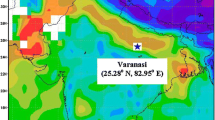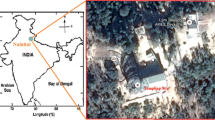Abstract
Seventy-two rainwater samples were investigated in some rural and urban sites across Cameroon for their chemical content. The objectives were to assess the potability of rainwater and the possible source of atmospheric inputs and to understand the biogeochemical cycles of the major ionic species. Rainwater in most of the sites was acidic (pH ranging from 4.92 to 6.41). A significant contribution of Ca2+ was observed in all sites, due mainly to the incorporation of soil dust in the precipitation. The K+ and NO3− contributions to the ionic load of rainwater in rural sites are a reflection of the dominant agricultural activities across Cameroon. High Ca2+, Mg2+, SO42−, and K+ to Na+ enrichment ratios relative to seawater ratios indicated the significant terrigenous influence on water chemistry, mainly from the Sahara dusts. About 62.5% of the samples were Ca2+-Mg2+-Cl−-SO42− water type. Based on TDS, major ion, and trace metal contents, rainwater is considered suitable for human consumption.
Access provided by Autonomous University of Puebla. Download conference paper PDF
Similar content being viewed by others
Keywords
1 Introduction
Rainfall signature integrates both the long-range transport of chemical species by clouds and the local scavenging of atmospheric aerosols during the rain event. These vary strongly both from event to event and within a single event because rainout and washout proportions strongly depend on the environment of the sampling site (urbanized, rural, or remote) (Bertrand et al. 2009). Understanding the main constituent of rainwater chemistry, what affects them, and their ecotoxicology is very important since rainwater plays a greats role in earth water storage replenishment and ecosystems’ life and equilibrium.
In spite of difficulties in collecting and preserving rain samples in tropic zones, precipitation chemistry in both rural and urban areas has been the subject of interesting research in the last few decades (Freydier et al. 2002; Sigha-Nkamdjou et al. 2003). However, in Cameroon, only few studies have been conducted on rainwater chemistry (Sigha-Nkamdjou et al. 2003; Galy-Lacaux et al. 2009; Wirmvem et al. 2014).
This study presents the chemical composition of rainwater determined at some urban and rural sites in Cameroon. This study is valuable in understanding the possible origin of atmospheric pollutants and the biogeochemical cycles of the major ionic species which are essential to determine deposition trends and improve modeling of atmospheric processes, as well as developing suitable emission control strategies.
2 Materials and Methods
Monthly rainfall samples were collected in Douala (January–November 2018), Yaoundé (January to September 2018), Dang (September to December 2018), and Ndop and Ndawara (June to October 2017). Douala and Yaoundé represent the urban sites, while Dang, Ndop, and Ndawara are located in the rural areas of Cameroon. Samples were collected monthly using artisanal bulk collectors. On the last day of the month, water from the container was properly shaken to mix and filter directly (through a 0.2 µm mesh) into a 100-mL bottle (previously rinsed with distilled water and dried in the laboratory to avoid contamination). The collected samples were stored in a refrigerator at 4 °C and analyzed for Na+, NH4+, K+, Mg2+, Ca2+, Cl −, NO3 –, and SO42− using standard methods. Alkalinity (HCO3−) was determined by titration. The trace metal content of rainwater samples from the urban sites was also analyzed.
4 Discussion
From the Piper diagram (Fig. 1), it is apparent that samples collected in the rural sites (Ndop, Ndawara, and Dang) are of the Ca2+-Mg2+-Cl−-SO42− water type, demonstrating the dominance of alkaline earths over alkali and strong acidic anions over weak acidic anions. In the urban sites (Douala and Yaoundé), the rains are of the Ca2+-Mg2+-HCO3− water type. This is corroborated by the slightly acidic character of rainwater sampled (see Table 2) resulting from the dissolution of NO3 and CO2 forming nitric and carbonic acids, respectively, whose effects have been neutralized by ionic species coming from soil dust particles.
Summary statistics of trace metal concentrations in rainwater sampled at Douala and Yaoundé (urban sites) are presented in Table 1. The most abundant trace metal in rainwater is Zn (145.11 ppb) followed by Fe (84.95 ppb). The high values of metals in rainwater samples may be due to local point sources of atmospheric pollution, long-range atmospheric transport of anthropogenic activities (like mining) from other parts of the country, and the soil dust which affects the composition of wet atmospheric deposition. The monthly concentration of some of the trace metals in rainfall at urban sites of Douala and Yaoundé was within the WHO guideline values for drinking water.
In order to determine the marine contribution in the composition of rainwater, the ratio of sea salts in rainwater was calculated considering Na+ as sea salt tracer and assuming that all Na+ was of marine origin. As shown in Table 3, the SO42−, K+, Ca2+, and Mg2+ to Na+ ratios of rainfall in both the urban and rural sites are higher than those in seawater basically suggesting a terrigenous origin of the ions. The dominance of Ca2+, SO42−, and K+ relative to Na+ and Cl− confirms the inference that precipitation in Sub-Saharan Africa is highly influenced by terrigenous dust mostly from the Sahara Desert soils (Goni et al. 2001; Freydier et al. 2002; Galy-Lacaux et al. 2009).
5 Conclusions
The results obtained reveal that the major source of chemical enrichment in rains in both rural and urban sites across Cameroon is terrigenous dust mainly from the Sahara Desert soils, and anthropogenic and agricultural activities. Concentrations of trace metals that were determined in the rainwater samples of urban sites are relatively low. Major ions and trace element concentrations in rainwater of all the sites were within the WHO guideline values for drinking water. Based on the chemical characteristics of rainwater in the studied sites, domestic harvesting of rainwater could be taken as an alternative to pipe-borne water supply.
References
Bertrand, G., Celle-Jeanton, H., Laj, P., Rangognio J., Chazot, G.: rainfall chemistry: long range transport versus below cloud scavenging. A two-year study at an inland station (Opme, France). J. Atmos. Chem. 60(3), 253–271 (2009)
Freydier, R., Dupré, B., Dandurand, J.L., Fortune, J.P., Sigha-Nkamdjou, L.: Trace elements and major species in precipitation at African stations: Concentrations and sources. Bull. Soc. Geo. Fr. 173(2), 129–146 (2002)
Galy-Lacaux, C., Laouali, D., Descroix, L., Gobron, N., Liousse, C.: Long term precipitation chemistry and wet deposition in a remote dry Savanna site in Africa (Niger). Atmos. Chem. Phys. 9(5), 1579–1595 (2009)
Goni, I.B., Fellman, E., Edmunds, W.M.: Rainfall geochemistry in the Sahel region of northern Nigeria. Atmosp. Environ. 35(25), 4331–4339 (2001)
Sigha-Nkamdjou, L., Galy-Lacaux, C., Pont, V., Richard, S., Sighomnou, D., Lacaux, J.P.: Rainwater chemistry and wet deposition over the Equatorial forested ecosystem of Zoétélé (Cameroon). J. Atmos. Chem. 46(2), 173–198 (2003). https://doi.org/10.1023/A:1026057413640
Wirmvem, M.J., Ohba, T., Fantong, W.Y., Ayonghe, S.N., Hogarh, J.N., Suila, J.Y., Asaah, AN.E., Ooki, S., Tanyileke, G., Hell, J.V.: Origin of major ions in monthly rainfall events at the Bamenda Highlands, NorthWest Cameroon. J. Environ. Sci. 26, 801–809 (2014)
Author information
Authors and Affiliations
Editor information
Editors and Affiliations
Rights and permissions
Copyright information
© 2022 The Author(s), under exclusive license to Springer Nature Switzerland AG
About this paper
Cite this paper
Foupouagnigni, A. et al. (2022). Rainwater Quality in Some Urban and Rural Sites of Cameroon (Central Africa). In: Chenchouni, H., et al. New Prospects in Environmental Geosciences and Hydrogeosciences. CAJG 2019. Advances in Science, Technology & Innovation. Springer, Cham. https://doi.org/10.1007/978-3-030-72543-3_89
Download citation
DOI: https://doi.org/10.1007/978-3-030-72543-3_89
Published:
Publisher Name: Springer, Cham
Print ISBN: 978-3-030-72542-6
Online ISBN: 978-3-030-72543-3
eBook Packages: Earth and Environmental ScienceEarth and Environmental Science (R0)





